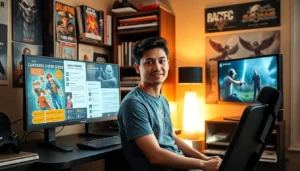In a world where creativity knows no bounds, the question arises: can ChatGPT-4 whip up stunning images? Picture this: you’re chatting away with an AI, and suddenly, it’s conjuring up visuals that make Picasso look like a doodler. That’s the dream, right? But before you start expecting your new AI buddy to paint your living room walls, let’s dive into the reality of what ChatGPT-4 can actually do.
Table of Contents
ToggleOverview of ChatGPT-4
ChatGPT-4 represents an advanced iteration of OpenAI’s language model. This version offers enhanced capabilities compared to its predecessors, focusing on generating human-like text responses. While it excels in natural language processing, it does not inherently create images. Instead, ChatGPT-4 specializes in text-based content generation, offering insights and generating creative narratives.
Although it cannot produce visual art directly, users can leverage its linguistic strengths to conceptualize ideas for images. They can describe these concepts in detail, allowing other tools to visualize them. This indirect approach maintains a strong connection between the text output and the desired visual result.
ChatGPT-4 employs deep learning techniques, resulting in an improved understanding of context and user intent. The model generates responses that better align with user queries, crafting detailed suggestions and recommendations. More sophisticated prompts can yield more creative and engaging text, setting a higher standard for interaction.
Data from user reviews and case studies indicates positive feedback regarding ChatGPT-4’s performance in creative tasks. Many find it helpful when brainstorming visual concepts, although it remains essential to use dedicated image generation models for actual artwork. Users can explore various compatibilities between ChatGPT-4 and other tools for a more holistic experience.
While not a tool for image creation, ChatGPT-4 serves as a powerful companion for ideation and text generation, paving the way for seamless collaboration with platforms designed for visual outputs. Understanding these distinctions helps users navigate the capabilities of ChatGPT-4 effectively.
Capabilities of ChatGPT-4

ChatGPT-4 showcases a range of capabilities focused primarily on text rather than image generation. Users can utilize its advanced text generation to enhance various projects effectively.
Text Generation
Conversational abilities shine with ChatGPT-4’s text generation feature. This model excels at producing coherent and creative text, allowing users to explore ideas freely. In numerous applications, it creates engaging content for storytelling, brainstorming, and drafting. Deep learning techniques enable improved context understanding, ensuring content aligns with user intent. Users often find success when seeking inspiration for visual content, utilizing ChatGPT-4 to generate vivid descriptions. Feedback confirms its effectiveness in elevating creative tasks, prompting additional exploration of concepts.
Image Generation
While ChatGPT-4 does not create images directly, it remains a vital tool for visual ideation. Users can rely on its text-generation strengths to generate detailed prompts that guide image creation in other dedicated tools. A variety of platforms exist, specializing in translating textual descriptions into visuals based on specifications. Articulating ideas clearly enhances the potential of these platforms. Collaborating with ChatGPT-4 amplifies the creative process, allowing for a more structured approach. Overall, this synergy between text and image tools yields promising results for users seeking visual outcomes.
Understanding Image Creation Technologies
Image creation technologies continue to evolve. These tools harness the power of artificial intelligence to generate visuals based on textual input or user guidance.
AI and Image Synthesis
AI technologies enable image synthesis through deep learning techniques. Generative Adversarial Networks (GANs) significantly contribute to this process. They consist of two neural networks, a generator and a discriminator, that improve image quality over time. Text-to-image synthesis tools can interpret descriptions provided by users, converting language into visuals. OpenAI’s DALL-E exemplifies this capability, producing detailed images from written prompts. Users benefit from these AI tools, finding inspiration and creative direction through their image outputs.
Comparison with Other Models
Different models excel in various aspects of image generation. DALL-E, for instance, specializes in translating text into images, whereas other models may focus solely on style transfer or image enhancement. Stable Diffusion stands out for its remarkable ability to generate high-quality images quickly and efficiently. Midjourney, another notable example, offers unique artistic style options. Each model operates under specific algorithms and architectures, leading to diverse image generation outcomes. Understanding these differences helps users choose the right tools for their visual projects.
Use Cases for Image Generation
ChatGPT-4 enhances image generation by providing rich textual descriptions that feed into dedicated visual tools. Many users turn to it for practical applications, harnessing its linguistic capabilities to brainstorm creative concepts and generate prompts.
Practical Applications
Creative professionals utilize ChatGPT-4 in diverse fields. Designers often employ it to draft precise prompts for visual projects. Marketers find value in using it to create compelling visual ad concepts. Writers can depend on it for generating imagery ideas, enhancing storytelling through vivid descriptions. Educators leverage its strengths for lesson planning, curating engaging visuals for learning materials.
Limitations and Challenges
Despite its strengths, ChatGPT-4 faces limitations in direct image generation. Users must rely on external platforms for actual visuals, which may not always align perfectly with the generated text. Discrepancies can occur between the descriptive text and the final image, leading to potential misinterpretations. It lacks the nuanced understanding of artistic intent and style that advanced image generation tools provide. Relying solely on ChatGPT-4 for visuals may hinder the creative process, requiring additional verification through other resources.
ChatGPT-4 stands as a remarkable tool for generating rich and detailed text descriptions that can inspire visual content. While it doesn’t create images directly, its capabilities in natural language processing make it an invaluable resource for users looking to conceptualize ideas for visuals. By collaborating with dedicated image generation platforms, users can transform ChatGPT-4’s vivid descriptions into stunning visuals.
Understanding the interplay between text and image generation enhances the creative process for professionals across various fields. As technology evolves, leveraging tools like ChatGPT-4 will continue to play a crucial role in ideation and visual storytelling. Embracing its strengths while recognizing its limitations allows users to maximize their creative potential effectively.


